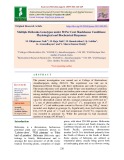
Plant’s transpiration rate
-
Ebook "Janice VanCleave’s great science project ideas from real kids" saves you time and effort by showing you how to develop your project from start to finish and offering useful design and presentation techniques. Projects are in an easy-to-follow format, use easy-to-find materials, and include dozens illustrations and diagrams that show you what kinds of charts and graphs to include in your science project and how to set up your project display.
 147p
147p  dangsovu
dangsovu
 20-10-2023
20-10-2023
 5
5
 3
3
 Download
Download
-
Lead (Pb) is a harmful pollutant that disrupts normal functions from the cell to organ levels. Salix babylonica is characterized by high biomass productivity, high transpiration rates, and species specific Pb. Better understanding the accumulating and transporting Pb capability in shoots and roots of S. babylonica, the toxic effects of Pb and the subcellular distribution of Pb is very important.
 15p
15p  vijichea2711
vijichea2711
 28-05-2021
28-05-2021
 5
5
 1
1
 Download
Download
-
The major production constraint for okra is yellow vein mosaic disease, causing losses with regard to the quality and as well as the yield. This is a viral disease occurring on bhendi. Yellowing of the entire network of veins in the leaf blade is the characteristic symptom. In severe infections, the younger leaves turn yellow to become entirely chlorotic and the plant is highly stunted.
 5p
5p  trinhthamhodang9
trinhthamhodang9
 16-12-2020
16-12-2020
 13
13
 2
2
 Download
Download
-
The performance and water use efficiency (WUE) of Chrysanthemum var. Marigold was evaluated under two moisture regimes, i.e., 100 % FC and 70 % FC imposed and maintained using gravimetric method. At 100 % FC, the plant height (30.33 cm), average plant spread (38.21 cm), number of primary branches/plant (5.67) and secondary branches/plant (4.67), number of leaves/plant (71.67), number of flowers/plant (136.75), average weight of individual flowers (7.21g), RWC (94.29%), root: shoot ratio (0.42), total fresh bio mass (153.09 g), flower yield (881.67 g / plant) and shelf life of 7.
 14p
14p  angicungduoc6
angicungduoc6
 22-07-2020
22-07-2020
 10
10
 2
2
 Download
Download
-
The study was carried out to assess the genetic variability and association of traits with respect to seed yield and its components in sesame genotypes. Seventy five sesame genotypes were grown during kharif 2016 at the Project Coordinating Unit Sesame and Niger, JNKVV, Jabalpur for the estimation of phenotypic and genotypic variances, heritability, genetic advances, correlation and path coefficient analysis for seed yield and yield related traits. High values for phenotypic coefficient of variation (PCV) and genotypic coefficient of variation (GCV) was recorded for traits viz.
 9p
9p  gaocaolon5
gaocaolon5
 14-06-2020
14-06-2020
 21
21
 1
1
 Download
Download
-
An experiment was conducted at Agricultural college farm, Bapatla, Andhra Pradesh to study the „Assessment of effect of different dust (cement, stone crusher, and lime) pollutants at various levels on total chlorophyll content, transpiration rate and yield of blackgram (Phaseolus mungo L.). The experiment revealed that with an increase in applied dust leads to the decrease in total chlorophyll content and transpiration rate in plants that further engender lesser yields compared to the control.
 7p
7p  nguathienthan4
nguathienthan4
 21-04-2020
21-04-2020
 11
11
 0
0
 Download
Download
-
Physio-biochemical parameters were recorded under moisture stress and normal condition of tolerant and susceptible cotton G. hirsutum genotypes, when plants experiencing moisture stress at 65-67 DAS (15-17 days of water withholding and 80-82 DAS (30 days water withholding).
 19p
19p  quenchua4
quenchua4
 06-04-2020
06-04-2020
 18
18
 1
1
 Download
Download
-
Setting up water-saving irrigation strategies is a major challenge farmer‟s face, in order to adapt to climate change and to improve water-use efficiency in crop productions. However, there is an increasing need to strategize and plan irrigation systems under varied climatic conditions to support efficient irrigation practices while maintaining and improving the sustainability of ground- water systems.
 17p
17p  caygaocaolon2
caygaocaolon2
 11-03-2020
11-03-2020
 17
17
 0
0
 Download
Download
-
This research was conducted during 2015-16 and 2016-17 kharif seasons in the Department of Horticulture, S. K. N. Agriculture University, Jobner, Jaipur (Rajasthan) to measure the influence on various physiological parameters of vegetable cowpea legume crop using growth substances and bio-fertilizers. The highest relative leaf water content (61.90%), transpiration rate (2.24m mol H2O/m2 /s) and leaf diffusion resistance (78.03s cm-2 ) were obtained in Brassinoids @ 0.50 ppm whereas lowest leaf osmotic potential (1.
 7p
7p  cothumenhmong3
cothumenhmong3
 22-02-2020
22-02-2020
 16
16
 1
1
 Download
Download
-
The present investigation was carried out at College of Horticulture, Anantharajupeta during 2018-19. The experiment was laid out in Randomized Block Design, with three replications and with 8 genotypes. The treated rhizomes were planted under 50 per cent shadehouse condition. All the physiological attributes and anthocyanin content varied significantly among multiple heliconia genotypes studied under shadehouse conditions. Among different genotypes tried, leaf area (814.57 cm2 ), SPAD (SCMR) value for chlorophyll content (65.62), stomatal conductance (0.
 10p
10p  cothumenhmong3
cothumenhmong3
 22-02-2020
22-02-2020
 14
14
 0
0
 Download
Download
-
An attempt was made to screen forty native AM fungal isolates from the soybean rhizosphere of Belagavi and Dharwad districts based on their peroxidise activity and total dry matter accumulation in soybean under the restricted water regime of -500 kPa. Top three fungal isolates viz., UASDAMFS15, UASDAMFS25 and UASDAMFS36 tentatively identified as G. maculosum, G. manihotis and G. globiferum respectively. For pot culture studies three irrigation regimes were maintained viz., -33 kPa -500 kPa and -1000 kPa. An experiment was laid out in completely randomized design with factorial concept.
 12p
12p  trinhthamhodang3
trinhthamhodang3
 14-02-2020
14-02-2020
 13
13
 0
0
 Download
Download
-
the primary objective of the is to deliver a thoughtful combination of viewpoints which will be valuable to workers in all places of plant sciences. the material included in this will be important in building methods to counter water anxiety in crops. vegetation encounter drinking water anxiety both when the h2o provide to their roots becomes limiting, or when the transpiration rate gets to be intense. h2o stress is primarily caused by a h2o deficit, this sort of as a drought or higher soil salinity....
 312p
312p  ktct_1669
ktct_1669
 09-05-2012
09-05-2012
 87
87
 17
17
 Download
Download
-
Abstract Physiological and biochemical responses induced by salt stress were studied in laboratory-grown young plants of the mangrove, Bruguiera gymnorrhiza. The growth rates and leaf areas were highest in the culture with 125 mM NaCl. Transpiration rates showed a diel periodicity when the plants were placed in water, but the oscillatory cycles disappeared for plants placed in higher
 14p
14p  nguyenngocsonctu
nguyenngocsonctu
 24-11-2010
24-11-2010
 95
95
 8
8
 Download
Download
-
Abstract: The impact of salinity on three arboreal mangrove plants, Sonneratia apetala (Sa), S. caseolaris (Sc) and Rhizophora stylosa (Rs), was studied. The three mangrove species were treated with different salinity levels over a three-month period. The response and adaptation of these three mangrove species to salinity were shown to be different. Net photosynthesis rate, stomata conductance and transpiration rate of leaves decreased and soluble sugar content in leaves increased, with salt concentration in all three mangrove species.
 6p
6p  nguyenngocsonctu
nguyenngocsonctu
 24-11-2010
24-11-2010
 107
107
 12
12
 Download
Download
CHỦ ĐỀ BẠN MUỐN TÌM









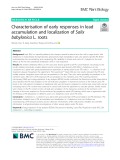
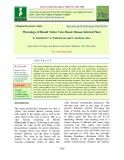
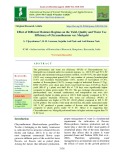
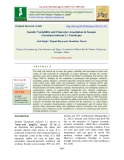
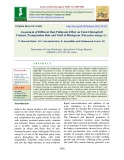


![Influence of plant growth substances and bio-fertilizers on physiological parameters of vegetable cowpea [Vigna unguiculata (L.) Walp] Influence of plant growth substances and bio-fertilizers on physiological parameters of vegetable cowpea [Vigna unguiculata (L.) Walp]](https://tailieu.vn/image/document/thumbnail/2020/20200222/cothumenhmong3/135x160/2691582383205.jpg)
